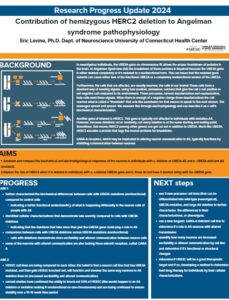 Eric Levine, PhD University of Connecticut
Eric Levine, PhD University of Connecticut Contribution of hemizygous HERC2 deletion to Angelman syndrome pathophysiology
$200,000
2 years
Individuals with a deletion of chromosome 15q11-q13 suffer from Angelman syndrome (AS), a neurogenetic developmental disorder characterized by intellectual disability, motor ataxia, absent speech, and seizures. The specific gene that is responsible for AS encodes the ubiquitin protein ligase UBE3A, although other genes in the region are also deleted.
AS can also result from loss of function mutations of UBE3A, which spares the other genes located in the region. UBE3A mutation AS patients typically have a less severe phenotype, especially with regard to cognitive and motor dysfunction and the incidence of epilepsy. This suggests that the loss of other genes in the region, in addition to UBE3A, likely contribute to the more severe phenotype in deletion AS patients. In particular, the HERC2 gene, which also encodes an E3 ubiquitin ligase, is located within the region typically deleted in AS.
Loss-of function mutation of HERC2 itself causes a severe neurodevelopmental phenotype with Angelman syndrome-like features. We hypothesize that the hemizygous loss of HERC2 contributes to the more severe behavioral phenotype in deletion AS individuals, and in conjunction with loss of UBE3A, will result in increased severity of cellular phenotypes in human AS stem cell-derived neurons.
We will test this hypothesis by comparing electrophysiological and morphological phenotypes of AS neurons derived from mutation and deletion AS patients. We will use antisense oligonucleotide and CRISPR-editing approaches to determine if reducing HERC2 expression in UBE3A-deficient neurons will confer the increased excitability, altered synaptic transmission, and other cellular phenotypes seen in neurons derived from AS deletion individuals. These studies will shed light on the cellular mechanisms responsible for behavioral phenotypes in AS and identify molecular targets for development of novel therapeutics.
Summary & Update
In neurotypical individuals, the UBE3A gene on chromosome 15 allows the proper breakdown of proteins in the brain. In Angelman Syndrome (AS) the breakdown of these proteins is impaired because the UBE3A gene is either deleted completely or it’s mutated to a nonfunctional form. This can mean that the mutated gene variants can cause either less of the functional UBE3A or a completely nonfunctional version of the UBE3A.
Furthermore, the cells that are affected, are usually neurons, the cells in our brains! These cells have a standard way of sending signals, using ions (sodium, potassium, calcium) that give the cell a net positive or net negative cell compared to its environment. These processes, termed depolarization and repolarization, help cells send those signals. When there is enough of a negative charge (from depolarization) the cell reaches what is called a “threshold” that acts like permission for that neuron to speak to the next neuron. The messages spread and spread. We measure this through electrophysiology and can describe it as a cell’s biochemical characterization.
Another gene of interest is HERC2. This gene is typically not affected in individuals with mutation-AS. However, because deletions occur randomly, not every deletion is at the same starting and ending point. Sometimes, this means HERC2 (among other genes) can get cut out in addition to UBE3A. Much like UBE3A,HERC2 encodes a protein that tags the neuron proteins for breakdown.
GABA-A receptors, which may be implicated in altering neuron communication in AS, typically functions by inhibiting communication between neurons.


